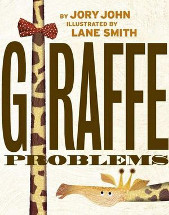Giraffe problems by Jory John

Ill. by Lane Smith. Walker Books, 2018. ISBN 9781406383164
(Age: 5-8) Themes: Differences, Individual Characteristics. The book
begins with Edward the giraffe telling us his problem: 'I feel bad
about my neck. I do. I can't help it. It's too long. Too bendy . . .
Too . . . necky.' He tell us all the ways he has tried to hide it or
dress it up. All the other animals seem to have glorious, perfect
necks. But his makes him want to hide until the sun sets. His tirade
of self-loathing is just ending when he accidentally rests his
cumbersome neck on a turtle. Cyrus the turtle then begins telling
Edward about his own neck problems: 'I've been admiring your neck
from afar. Oh, how I wish my neck looked like yours! I'd get so much
done in a day'. And so he continues on his own little tirade. The
story is told with dry humour, making fun of their extreme vanity
and how focused they are on their own problem. The funniest part of
the book is when turtle tells us, using very descriptive
story-telling, of how he has waited for a week under a banana tree
for a piece of fruit to fall to the ground so he could 'sample its
sweetness and nourish myself in the process'. 'You want a banana
from a tree?' says Edward. 'That's what I said, yes'. Plunk, down
one comes. So, Cyrus praises Edward's neck and Edward waxes lyrical
about Cyrus's neck and they dress themselves up with bowties. 'I
feel good about our necks, Edward'. 'Thank you, Cyrus. For once, so
do I. Yes, for once, so do I . . . '
Lane Smith (It's a Book, The Stinky Cheese Man) has
used textured illustrations which are perfectly suited to the
animals and natural setting within this story and the
character-driven narrative. The colours used are mostly earthy
browns, yellows and greens. The reader can tell which animal is
speaking because of their individualised text style and colour; this
is a clever technique and it is always clear who is speaking, if not
from the content or placement within the picture then from the
typeface. This has a nice moral about accepting ourselves as we are
and celebrating what makes us unique. It is also about recognising
difference and how we can make use of those differences to work
together.
Nicole Nelson